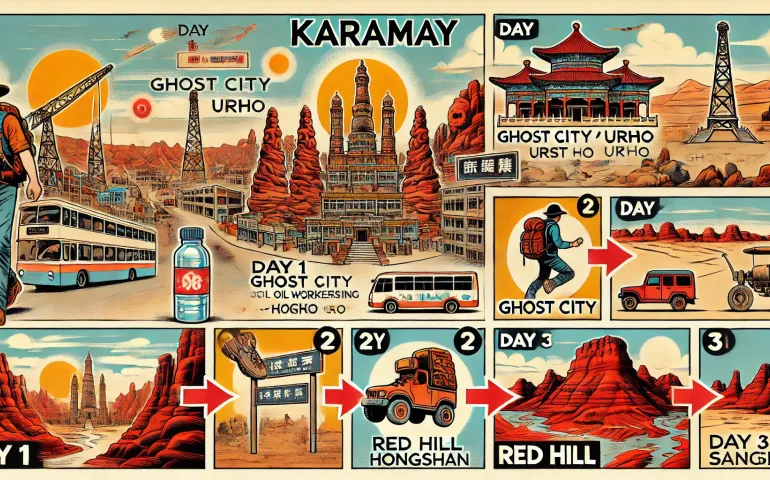Reasons to Visit
- Ghost City (Urho) : One of the most fascinating aspects of Karamay is the Ghost City, a natural wonder shaped by wind erosion over millions of years. This eerie, otherworldly landscape of rock formations is said to resemble ancient castles and fantastical creatures, giving it an almost supernatural ambiance, especially at sunset.
- Rich Oil History : Karamay is China's first large-scale oil production base, discovered in 1955. The city has grown around its oil industry, and visitors can explore its oil fields, visit the Oil Workers' Monument, and learn about the development of China's oil industry, making it a unique destination for those interested in industrial tourism.
- Red Hill (Hongshan) : Another remarkable natural site in Karamay is Red Hill, known for its deep red soil and unusual rock formations. This area is particularly striking during sunrise and sunset when the landscape glows with vibrant colors, offering breathtaking photo opportunities and a unique experience of Xinjiang's diverse natural beauty.
Visa
- For Chinese Citizens : No visa is required.
- For International Travelers : Most international travelers will need a Chinese visa to visit Karamay. Depending on the country of origin, travelers should apply for a tourist visa (L visa) before entering China. Some nationalities might be eligible for a visa-free transit policy if they plan to visit only certain regions of Xinjiang for a short period. Always check the latest visa requirements with the Chinese consulate or embassy in your home country.
Travel Expenses
- Travel to & from Destination :
- Round-trip airfare from Beijing to Karamay: approximately $500 per person, totaling $1,000 for two.
- Hotel Cost :
- Average hotel cost: $80 per night.
- Total stay for 2 nights: $160 for a standard room.
- Food Cost :
- Estimated $20 per person per meal.
- Total cost for 6 meals for two: $240.
- Activity Cost :
- Entry fees and tours: $50 per person.
- Total for two: $100.
- Near Destination Travel Cost :
- Car rental for 3 days: $50 per day, totaling $150.
- Fuel and other expenses: approximately $50.
- Total near destination travel cost: $200.
Total Estimated Travel Expenses : $1,700 for a couple.

Best Itinerary
Day 1 : Arrival and Introduction to Karamay
After arriving in Karamay, settle into your hotel and take some time to rest. Begin your exploration in the late afternoon with a visit to the Oil Workers’ Monument. Spend around two hours here, from 3:00 PM to 5:00 PM, learning about the city’s oil history. For lunch, try some local Xinjiang cuisine at Xinjiang Crescent Moon Restaurant, known for its flavorful lamb dishes. In the evening, take a leisurely walk around the city center, where you can see the mix of modern and traditional architecture. Enjoy dinner at Urumqi Huigang Restaurant, offering authentic Uyghur cuisine. Conclude your day with a visit to the Karamay Cultural Center for a night show if available, or simply relax at your hotel.
Day 2 : Exploring Ghost City (Urho)
Start your day early with a visit to Ghost City (Urho), leaving the hotel by 8:00 AM. Spend the morning exploring this unique landscape, from 9:00 AM to 12:00 PM. The eerie rock formations make for some amazing photography opportunities. Pack a light picnic lunch or stop at a local eatery near the site for traditional dishes like roasted mutton or naan bread. In the afternoon, continue exploring the area or take a guided tour to learn more about the geological history of Ghost City. Return to Karamay in the late afternoon. For dinner, head to Dapanji Hot Pot Restaurant to try the famous Xinjiang Dapanji (Big Plate Chicken). Spend the evening enjoying the quiet, starry desert night at a local bar or lounge.
Day 3 : Red Hill (Hongshan) and Departure
After breakfast, head out to Red Hill (Hongshan) for a morning hike, starting at 7:00 AM. Spend from 8:00 AM to 11:00 AM exploring the red sandstone formations and taking in the panoramic views. The hike is moderately challenging, so bring water and wear appropriate footwear. Have lunch at Hongshan Scenic Area Restaurant, where you can enjoy local delicacies with a view. After lunch, return to the hotel, pack up, and prepare for your departure. If time allows, visit the Karamay Museum in the afternoon to learn more about the city's natural history and culture. Finish your trip with a farewell dinner at Silk Road Hotel Restaurant, offering a mix of Chinese and Central Asian cuisine, before heading to the airport for your flight home.

Safety Tips
- Keep your passport and important documents secure.
- Always carry a copy of your hotel address in Chinese.
- Stay hydrated, especially in desert areas.
- Respect local customs and dress modestly.
- Avoid walking alone at night in unfamiliar areas.
- Use only licensed taxis and avoid hitchhiking.
- Be cautious of extreme weather conditions.
- Learn a few basic Chinese phrases for emergencies.
- Stay informed about any travel advisories.
- Purchase travel insurance before your trip.
Flights
- From Beijing to Karamay : China Southern Airlines, Air China, and China Eastern Airlines offer direct flights, typically taking around 4 hours. Costs range from $250 to $350 one-way.
- Train : No direct trains, so flying is recommended.
Hotels
- Karamay Petroleum Hotel : Known for its comfort and proximity to major attractions.
- Hongshan Hotel : Offers great views of Red Hill.
- Crown Plaza Hotel Karamay : A luxury option with modern amenities.
- Karamay Jinjiang Inn : Budget-friendly with essential facilities.
- Xinjiang Grand Hotel : Convenient location with traditional decor.
Contacts
- Indian Embassy in Beijing : +86-10-8531-2500
- Local Police : 110
- Ambulance : 120
- Firefighters : 119
Country
Closet Airport
- Karamay Airport (KRY)
Nearest City
- Urumqi
Heritage Sites
- Ghost City (Urho)
Airlines
- China Southern Airlines
- Air China
- China Eastern Airlines
Currency
- Chinese Yuan (CNY)
Languages Spoken
- Mandarin
- Uyghur
Real Story
The discovery of oil in Karamay is a pivotal moment in China's history, marking the beginning of the country's journey towards energy self-sufficiency. It was in 1955, during a nationwide search for domestic oil reserves, that a team of geologists identified significant oil deposits beneath the barren deserts of Xinjiang. This discovery was not just a local event but a national breakthrough, coming at a time when China was heavily dependent on imported oil.
Karamay's oil field quickly became a focal point of China’s oil industry. The government invested heavily in developing the region, transforming the once remote desert into a bustling industrial hub. Thousands of workers were mobilized to the area, enduring harsh conditions to extract the precious resource. Their efforts bore fruit, and Karamay soon became synonymous with black gold, a symbol of China’s industrial ambitions.
The development of Karamay’s oil field had far-reaching implications. It spurred economic growth, not only in Xinjiang but across China, as the oil extracted from Karamay fueled the nation’s factories, power plants, and vehicles. The city’s infrastructure expanded rapidly, with new roads, housing, and facilities springing up to accommodate the influx of workers and their families. Karamay also became a model for other oil-rich regions in China, demonstrating how oil could be the cornerstone of regional development.
However, the rapid industrialization of Karamay also brought challenges. The city had to balance its economic aspirations with environmental conservation. The local government implemented measures to mitigate the impact of oil extraction on the surrounding desert ecosystem, a task that remains ongoing as Karamay continues to grow.
Today, Karamay stands as a testament to the transformative power of natural resources. The city’s story is one of resilience, innovation, and the pursuit of progress. It is a place where the past and present intersect, where the discovery of oil not only changed the fate of a city but also played a crucial role in shaping the future of a nation.
Cuisine
Karamay’s cuisine is a delightful fusion of Uyghur, Han Chinese, and Central Asian flavors, reflecting the region's diverse cultural heritage. One of the must-try dishes is Dapanji (Big Plate Chicken), a hearty stew made with chicken, potatoes, and bell peppers, seasoned with garlic, chili, and Xinjiang spices, often served with hand-pulled noodles. Another local specialty is Kebabs, particularly lamb kebabs, which are marinated in a mixture of cumin, garlic, and chili powder, then grilled to perfection over open flames. Naan bread, a staple in Uyghur cuisine, is often enjoyed with these dishes, providing a delicious and filling complement to the rich flavors of the region.

Culture and History
Karamay, located in the northwestern part of China’s Xinjiang Uyghur Autonomous Region, is a city steeped in both industrial significance and cultural diversity. The city's name, derived from the Uyghur word meaning "black oil," is a nod to its rich oil reserves, which have shaped its history and development.
The discovery of oil in Karamay in 1955 marked a turning point in China’s industrial landscape. The city rapidly developed into a major oil production center, attracting workers from across the country. This influx of people brought a mix of cultures to Karamay, blending Han Chinese, Uyghur, and other ethnic influences. Despite its industrial focus, the city has maintained a connection to its natural surroundings, with landmarks like Ghost City (Urho) and Red Hill (Hongshan) showcasing the region’s unique geology.
Karamay’s cultural fabric is also woven with the traditions of the Uyghur people, who have lived in the region for centuries. The Uyghurs, a Turkic ethnic group, bring their language, music, dance, and cuisine to the cultural mosaic of Karamay. Visitors can experience this rich heritage in local markets, restaurants, and cultural performances. The city is a testament to the coexistence of industry and tradition, where the modern oil industry meets ancient cultures in a landscape of stark beauty.
In addition to its cultural diversity, Karamay has made significant strides in preserving its natural environment. The city’s efforts to balance industrial growth with environmental conservation are evident in its clean streets, green parks, and protected natural sites like the Ghost City. Karamay is a place where visitors can witness the intersection of history, culture, and nature, making it a unique and intriguing destination in China’s vast landscape.
